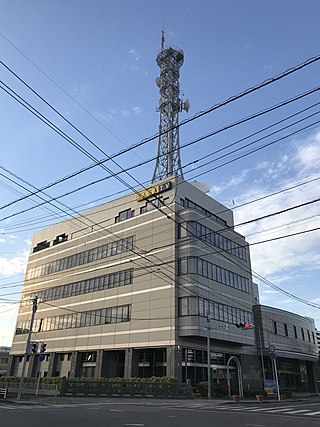Related Research Articles

Terrestrial television or over-the-air television (OTA) is a type of television broadcasting in which the signal transmission occurs via radio waves from the terrestrial (Earth-based) transmitter of a TV station to a TV receiver having an antenna. The term terrestrial is more common in Europe and Latin America, while in Canada and the United States it is called over-the-air or simply broadcast. This type of TV broadcast is distinguished from newer technologies, such as satellite television, in which the signal is transmitted to the receiver from an overhead satellite; cable television, in which the signal is carried to the receiver through a cable; and Internet Protocol television, in which the signal is received over an Internet stream or on a network utilizing the Internet Protocol. Terrestrial television stations broadcast on television channels with frequencies between about 52 and 600 MHz in the VHF and UHF bands. Since radio waves in these bands travel by line of sight, reception is generally limited by the visual horizon to distances of 64–97 kilometres (40–60 mi), although under better conditions and with tropospheric ducting, signals can sometimes be received hundreds of kilometers distant.

Mainichi Broadcasting System, Inc., or MBS, is a radio and television broadcasting company headquartered in Osaka, Japan, affiliated with Japan Radio Network (JRN), National Radio Network (NRN), Japan News Network (JNN) and TBS Network, serving in the Kansai region.

JOIX-DTV, branded as Yomiuri TV, is the Kansai region flagship station of the Nippon News Network and the Nippon Television Network System, owned by the Yomiuri Telecasting Corporation subsidiary of the eponymous Yomiuri Shimbun Holdings, Japan's largest media conglomerate; Yomiuri TV forms part of Yomiuri's main television broadcasting arm alongside Kantō region flagship Nippon TV, which owns a 15.89% share in the company. Founded as New Osaka Television Co. on February 13, 1958, and renamed Yomiuri Telecasting Corporation on August 1, the station started broadcasting on August 28 as the first TV station to be affiliated with Nippon Television Network Corporation. Its studios are located in the Osaka Business Park district of Osaka.

WGBX-TV, branded on-air as GBH 44, is the secondary PBS member television station in Boston, Massachusetts, United States. It is owned by the WGBH Educational Foundation, alongside WGBH-TV, WFXZ-CD, and multiple public radio stations in Boston and on Cape Cod. WGBX-TV, WGBH-TV and the WGBH and WCRB radio stations share studios on Guest Street in northwest Boston's Brighton neighborhood; WGBX-TV's transmitter is located on Cedar Street in Needham, Massachusetts.
TBS Radio, Inc. is a radio station in Tokyo, Japan, the flagship radio station of the Japan Radio Network (JRN). The company was founded by Tokyo Broadcasting System on March 21, 2000. TBS Radio started broadcasting on October 1, 2001.

WETA-TV is the primary PBS member television station in Washington, D.C. Owned by the Greater Washington Educational Telecommunications Association, it is a sister station to NPR member WETA. The two outlets share studios in nearby Arlington County, Virginia; WETA-TV's transmitter is located in the Tenleytown neighborhood in Northwest Washington.
Nebraska Public Media, formerly Nebraska Educational Telecommunications (NET), is a state network of public radio and television stations in the U.S. state of Nebraska. It is operated by the Nebraska Educational Telecommunications Commission (NETC). The television stations are all members of the Public Broadcasting Service (PBS), while the radio stations are members of National Public Radio (NPR).
WYIN, branded on-air as Lakeshore PBS, is a secondary PBS member television station licensed to Gary, Indiana, United States, serving the Chicago area. It is owned by Northwest Indiana Public Broadcasting, Inc., as a sister station to NPR member WLPR-FM (89.1). Both stations share studios on Indiana Place in Merrillville, while WYIN's transmitter is located near Lake Dalecarlia. WYIN is one of two PBS member stations in the Chicago television market, alongside Chicago-licensed WTTW.

WNYJ-TV was an independent non-commercial television station licensed to West Milford, New Jersey, United States. The station's transmitter was located in West Orange, New Jersey. Its broadcast license was owned by the Oakland, California–based Christian broadcast ministry Family Stations, who from 1996 through 2013 operated it as WFME-TV, a religious television station.

TV Kanagawa is an independent television station in Japan serving Kanagawa Prefecture and parts of the Greater Tokyo Area with favorable reception. The station was founded on April 20, 1971 and began broadcasting on April 1, 1972. Its call sign is JOKM-DTV and occupies the UHF channel 18 on the airwaves.

NHK General TV, abbreviated on-screen as NHK G, is the main television service of NHK, the Japanese public broadcaster. Its programming includes news, drama, quiz/variety shows, music, sports, anime, and specials which compete directly with the output of its commercial counterparts. The channel is well known for its nightly newscasts, regular documentary specials, and popular historical dramas. Among the programs NHK General TV broadcasts are the annual New Year's Eve spectacular Kōhaku Uta Gassen, the year-long Taiga drama, and the daytime Asadora.

NHK Educational TV, abbreviated on-screen as NHK E, is the second television service of NHK. It is a sister service of NHK General TV, showing programs of a more educational, documentaries, cultural, children's or intellectual nature, periodically also showing anime, and also airing programming from Nickelodeon. A similar counterpart would be PBS of the United States. NHK displays a watermark "NHK E" at the upper right for its digital TV broadcast. In 2010, NHK began using the abbreviation E Tele.
Television in Japan was introduced in 1939. However, experiments date back to the 1920s, with Kenjiro Takayanagi's pioneering experiments in electronic television. Television broadcasting was halted by World War II, after which regular television broadcasting began in 1950. After Japan developed the first HDTV systems in the 1960s, MUSE/Hi-Vision was introduced in the 1970s.

Kyushu Asahi Broadcasting Co., Ltd. is a broadcasting station in Fukuoka, Japan, and it is affiliated with National Radio Network (NRN) on radio and All-Nippon News Network (ANN) on TV.

TV Asahi Corporation, commonly abbreviated as Tere Asa (テレ朝), with the call sign JOEX-DTV, is a Japanese television station subsidiary of certified broadcasting holding company TV Asahi Holdings Corporation, itself controlled by The Asahi Shimbun Company serving as the flagship station of the All-Nippon News Network. Its studios are located in Roppongi, Minato, Tokyo. TV Asahi is one of the five private broadcasters based in Tokyo.

UHF television broadcasting is the use of ultra high frequency (UHF) radio for over-the-air transmission of television signals. UHF frequencies are used for both analog and digital television broadcasts. UHF channels are typically given higher channel numbers, like the US arrangement with VHF channels (initially) 1 to 13, and UHF channels (initially) numbered 14 to 83. Compared with an equivalent VHF television transmitter, to cover the same geographic area with a UHF transmitter requires a higher effective radiated power, implying a more powerful transmitter or a more complex antenna. However, the additional channels allow more broadcasters in a given region without causing objectionable mutual interference.
Events in 1964 in Japanese television.

Saga Television Station (株式会社サガテレビ), branded since 2015 as Saga TV, is the only commercial television station broadcasting to Saga. The station is affiliated to FNN and FNS since the station launched.

Shikoku Broadcasting is a radio and TV station based in Tokushima, Japan. It is affiliated to the Nippon News Network and Nippon Television Network System for TV and JRN/NRN for radio.

JOOY-DTV, virtual channel 4, branded as MBS TV, is the Kansai region key station of the Japan News Network, owned by Mainichi Broadcasting System, Inc.
References
- ↑ "映像と資料で振り返る 55年前 吉田茂元総理の「国葬」は". NHK News. NHK Online. 2022-09-07. Retrieved 2022-09-07.
- 1 2 Fifty Years of Broadcasting History Materials, page 805, published by NHK
- ↑ Japanese TV and radio launch date database
- ↑ "マッハGoGoGo". Tatsunoko Productions (in Japanese). Archived from the original on February 19, 2009. Retrieved 2010-03-30.